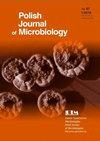突尼斯FalseniWautersiella产生的一种新型金属-β-内酰胺酶的全基因组测序检测
IF 1.6
4区 生物学
Q4 MICROBIOLOGY
引用次数: 1
摘要
摘要假华氏菌是黄杆菌科中一种罕见的非发酵革兰氏阴性菌。这种医院内病原体可导致多种人类感染,尤其是在免疫功能低下的患者中。在这里,我们描述了从突尼斯一名患有尿路感染的35岁女性的尿液样本中分离出的临床假丝酵母菌株的全基因组序列。我们研究了它的表型和基因型。在用MALDI-TOF方法鉴定细菌后,对该菌株进行全基因组测序。该分离物对各种抗生素不敏感,包括β-内酰胺类、氨基糖苷类和喹诺酮类。然而,它仍然对亚胺培南(MIC=0.25 mg/l)、厄他培南(MIC=0.75 mg/l)和美罗培南(MIC=0.19 mg/l)敏感。有趣的是,E-EST®(MP/MPI)显示美罗培南+/−EDTA的MIC降低(0.064μg/ml)。此外,在βCARBA测试中,只有在培养24小时后,颜色才会从黄色变为红色,这可以通过两种方式来解释。一方面,由于编码金属β-内酰胺酶的基因可能低表达。另一方面,更可能的是,这可能是一个假阳性结果,因为根据测试制造商的建议,测试应该在30分钟后读取。因此,也许这个基因在测试菌株中没有表达。此外,全基因组序列分析表明,存在一种新的染色体定位的B1亚类金属-β-内酰胺酶EBR样酶,与先前描述的由Empedobacter brevis产生的碳青霉烯酶EBR-1具有94.92%的氨基酸同一性。结果还显示了其他抗生素抗性基因的检测和质粒的缺失。到目前为止,这项研究是突尼斯首次发现假丝酵母的报告。这些发现证明假丝酵母可能是抗生素耐药性基因(如β-内酰胺酶)的潜在宿主。应建立合作努力和有效的卫生措施,以防止该物种在我们的医疗保健环境中出现。本文章由计算机程序翻译,如有差异,请以英文原文为准。
Detection By Whole-Genome Sequencing of a Novel Metallo-β-Lactamase Produced By Wautersiella Falsenii Causing Urinary Tract Infection in Tunisia
Abstract Wautersiella falsenii is a rarely non-fermenting Gram-negative bacterium and belongs to the Flavobacteriaceae family. This nosocomial pathogen can cause several human infections, especially among immunocompromised patients. Here, we describe the whole genome sequence of a clinical W. falsenii strain isolated from a urine sample of a 35-year-old woman with a urinary tract infection in Tunisia. We investigated its phenotype and genotype. After bacterial identification by the MALDI-TOF method, the whole-genome sequencing of this strain was performed. This isolate was not susceptible to various antibiotics, including β-lactams, aminoglycosides, and quinolones. However, it remains susceptible to imipenem (MIC = 0.25 mg/l), ertapenem (MIC = 0.75 mg/l), and meropenem (MIC = 0.19 mg/l). Interestingly, the E-TEST® (MP/MPI) showed a reduced MIC of meropenem +/− EDTA (0.064 μg/ml). Besides, the color change from yellow to red in the β CARBA test only after 24 hours of incubation can be interpreted in two ways. On the one hand, as a likely low expression of the gene encoding metallo-β-lactamase. On the other hand, and more likely, it may be a false-positive result because, according to the test manufacturer's recommendations, the test should be read after 30 minutes. Perhaps, therefore, this gene is not expressed in the tested strain. Moreover, the whole-genome sequence analysis demonstrated the presence of a novel chromosomally located subclass B1 metallo-β-lactamase EBR-like enzyme, sharing 94.92% amino acid identity with a previously described carbapenemase produced by Empedobacter brevis, EBR-1. The results also showed the detection of other antibiotic resistance genes and the absence of plasmids. So far, this study is the first report on the detection of W. falsenii in Tunisia. These findings prove that W. falsenii could be a potential reservoir of antibiotic resistance genes, e.g., β-lactamases. Collaborative efforts and effective hygiene measures should be established to prevent the emergence of this species in our health care settings.
求助全文
通过发布文献求助,成功后即可免费获取论文全文。
去求助
来源期刊

Polish Journal of Microbiology
MICROBIOLOGY-
CiteScore
3.70
自引率
4.80%
发文量
41
审稿时长
2 months
期刊介绍:
Polish Journal of Microbiology (PJM) publishes original research articles describing various aspects of basic and applied microbiological research. We are especially interested in articles regarding
- basic biological properties of bacteria and archaea, viruses, and simple
- eukaryotic microorganisms
- genetics and molecular biology
- microbial ecology
- medical bacteriology and public health
- food microbiology
- industrial microbiology
- bacterial biotechnology
 求助内容:
求助内容: 应助结果提醒方式:
应助结果提醒方式:


